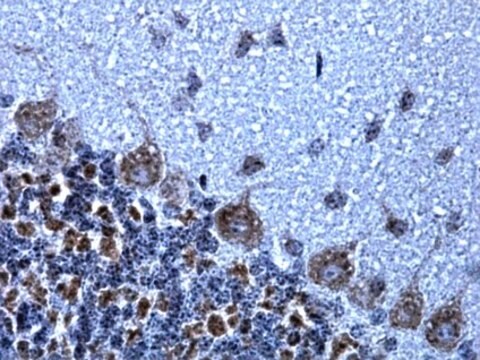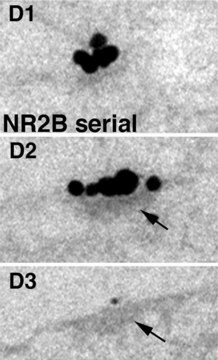AB1557P
Anti-NMDAR2B Antibody
Chemicon®, from rabbit
Synonyme(s) :
N-methyl D-aspartate receptor subtype 2B, N-methyl-D-aspartate receptor subunit 2B, N-methyl-D-aspartate receptor subunit 3, glutamate receptor subunit epsilon-2, glutamate receptor. ionotropic, N-methyl D-aspartate 2B, Glutamate
About This Item
Produits recommandés
Source biologique
rabbit
Niveau de qualité
Forme d'anticorps
affinity isolated antibody
Type de produit anticorps
primary antibodies
Clone
polyclonal
Espèces réactives
mouse, rat, human
Fabricant/nom de marque
Chemicon®
Technique(s)
immunohistochemistry: suitable
immunoprecipitation (IP): suitable
western blot: suitable
Numéro d'accès NCBI
Numéro d'accès UniProt
Conditions d'expédition
dry ice
Modification post-traductionnelle de la cible
unmodified
Description générale
′
Spécificité
Immunogène
Application
Neurosciences
μμ
Neurotransmetteurs et récepteurs
Description de la cible
Forme physique
Stockage et stabilité
Remarque sur l'analyse
Autres remarques
Informations légales
Clause de non-responsabilité
Not finding the right product?
Try our Outil de sélection de produits.
En option
Code de la classe de stockage
11 - Combustible Solids
Classe de danger pour l'eau (WGK)
WGK 1
Certificats d'analyse (COA)
Recherchez un Certificats d'analyse (COA) en saisissant le numéro de lot du produit. Les numéros de lot figurent sur l'étiquette du produit après les mots "Lot" ou "Batch".
Déjà en possession de ce produit ?
Retrouvez la documentation relative aux produits que vous avez récemment achetés dans la Bibliothèque de documents.
Notre équipe de scientifiques dispose d'une expérience dans tous les secteurs de la recherche, notamment en sciences de la vie, science des matériaux, synthèse chimique, chromatographie, analyse et dans de nombreux autres domaines..
Contacter notre Service technique





